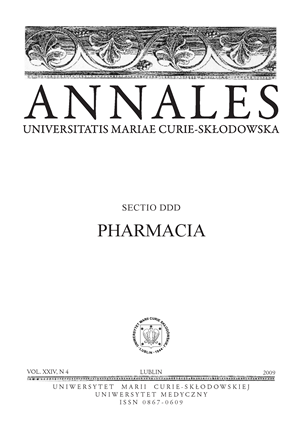Serum CETP level in post-renal transplant patient (Tx)
Abstract
Cholesterol ester transfer protein (CETP) is principally associated with HDL in plasma and it plays the role of a key modulator not only of the intravascular metabolism of HDL and apoA-I but also triglyceride(TG)-rich lipoproteins and low-density lipoprotein, it mediates the transfer of cholesteryl esters from HDL to proatherogenic apoB-lipoproteins, with heterotransfer of TG mainly from VLDL to HDL. The studies were performed in 42 post-renal transplant patients (Tx) (women, n=20 and men, n=22) at the age between 21–60 years. The post-renal transplant patients received cyclosporine A + prednisone (n=28), tacrolimus + prednisone (n=11) and sirolimus + prednisone (n=3). Hypertensive patients with hypercholesterolemia and hypertriglyceridemia treated with fibrate and athorvastatin or simvastatin used anti-hypertensive medications. Forty five healthy patients were the reference group (22 women and 23 men, aged 22 to 60 years). Tx patients were divided into 2 groups: triglyceride (TG)>150mg/dl and TG<150 mg/dl using TG concentration of 150mg/dl as a cut-point. The aim of this study was to investigate serum lipid and lipoprotein profiles and lipid and lipoprotein ratios, CETP levels and BMI index in post-renal transplant patients with TG>150mg/dl and TG<150mg/dl. Tx patients with TG>150 mg/dl had TG, TC, nonHDL-C, and lipid ratios (TC/HDL-C, TG/HDL-C) significantly higher but lipoprotein ratios (apoAI/apoB, HDL-C/apoAI) were significantly lower as a comparison to patients with TG<150mg/dl. However, lipids (TG, TC, LDL-C, nonHDL-C, HDL-C) and lipid ratios (TC/HDL-C, LDL-C/HDL-C, TG/HDL-C) and lipoproteins (apoAI, apoB) and lipoprotein ratios (apoAI/apoB, HDL-C/apoAI) in both groups were significantly disturbed as compared to healthy subjects. Moreover, both studied groups of Tx patients had no change in CETP levels and were non-statistically different as compared to the reference group. We conclude that Tx patients with hypertriglyceridemia received statins and immunosuppressive therapy tend to exclude dysregulation of CETP in the pathogenesis of dyslipidemia but future studies are required.
References
1. Boekholdt S. M., Sacks F. M., Jukema J. W. et al.: Cholesteryl ester transfer protein Taq1B variant, high-density lipoprotein cholesterol levels, cardiovascular risk, and efficacy of provastatin treatment: individual levels patients meta-analysis of 13.677 subjects. Circulation, 111, 278, 2005.
2. Chapman M. J., Goff W., Guerin M., Kontush A.: Cholesteryl ester transfer protein: at the heart of the action of lipid-modulating therapy with statins, fibrates, niacin, and cholesteryl ester transfer protein inhibitors. European Heart Journal, 10, 3, 2009.
3. Chapman M.J.: Therapeutic elevation of HDL-C to prevent atherosclerosis and coronary heart disease. Pharmacol. Ther., 111, 893, 2006.
4. de Vries R., Perton F. G., Dallina-Thie G. M. et al.: Plasma cholesteryl ester transfer is a determinant of intima-media thickness in type 2 diabetic and nondiabetic subjects : role of CETP and triglycerides. Diabetes, 54, 3554, 2005.
5. de Vries-van der Weil J., Zadelaar S., Toet K. et al.: Human CETP aggravates atherosclerosis by increasing HDL-cholesterol in APOE*3-Leiden mice. 206, 153, 2009.
6. Do H.Q., Nazih H., Luc G., Arvei ler D. et al.: Influence of cholesteryl ester transfer protein, peroxisome proliferator-activated receptor, apolipoprotein E, and apolipoprotein AI polymorphism on high-density lipoprotein cholesterol, apolipoprotein A-I, lipoprotein A-I, and lipoprotein A-I:A-II concentrations: the Prospective Epidemiological Study of Myocardial Infarction study. Metab. Clin. and Exp., 58, 283, 2009.
7. Fellstrom B., Holdaas H., Jardine A.: Cardiovascular Disease in Renal Transplantation: Management by Statins. Transplant. Rev., 18, 122, 2004.
8. Friedewald W.T., Levy R. I., Friedrickson D. S.: Estimation of the concentration of lowdensity lipoprotein cholesterol in plasma without the use of the preparative ultracentrifuge. Clin. Chem., 18, 499, 1972.
9. K/DOQI Clinical Practice Guidelines for Chronic Kidney Disease: Evaluation, Classification, and Stratification. Am. J. Kidney Dis., 39, supl. 1, 1, 2002.
10. Kasiske B. L., Cakkera H. A., Roel J.: Explained and unexplained ischemic heart disease risk after renal transplantation. J. Am. Soc. Nephrol., 11, 1735, 2000.
11. Kimak E., Hałabiś M.: Serum hypertriglyceridemia as an important risk factor of chronić allograft failure in post-renal transplant patients. Annales UMCS, Sectio DDD, vol. XXII, 115, 2009.
12. Kimak E., Solski J.: Serum lipid, lipoprotein, leptin, and CETP levels in healthy mem and healthy women. Annales UMCS, Sectio DDD, vol. XXI, 343, 2008.
13. Massy Z. A.: Hyperlipidemia and cardiovascular disease after organ transplantation. Transplantation, 72(s6), 13, 2001.
14. Montanaro D., Gropuzzo M., Tulissi P. et al.: Cardiovascular disease after renal transplantation. G Ital. Nefrol., 21(s26), 53, 2004.
15. Ojo A. O.: Cardiovascular complications after renal transplantation and their prevention. Transplantation, 82, 603, 2006.
16. Pahl M. V., Ni Z., Sepassi L., Moradi H., Vazi ri N. D.: Plasma phospholipid transfer protein, cholesteryl ester transfer protein and lecithin : cholesterol acyltransferase in end-stage renal disease (ESRD). Neprol. Dial. Transplant., 24, 2541, 2009.
17. Salerno A. G., Patricio P. R., Berti J. A., Olivei ra H. C.: Cholesteryl ester transfer protein (CETP) increases postprandial triglyceridemia and delays triacylglycerol plasma clearance in transgenic mice. Biochem. J., 419, 629, 2009.
18. Thompson A., Di Angelantonio E., Sarwar N. et al.: Association of cholesteryl ester transfer protein genotypes with CETP mass and activity, lipid levels, and coronary risk. Jama, 299, 2777, 2008.
19. Tory R., Sachs-Barrable K., Goshko C.B., Hill J. S., Wasan K.M.: Tacrolimus-Induced Elevation in Plasma Triglyceride Concentration after Administration to renal Transplant Patients in Partially Due to a Decrease in Lipoprotein Lipase Activity and Plasma Concentration. Transplantation, 1(88), 62, 2009.
20. Zeller M., Masson D., Farnier M., Lorgis L., Decker t V. et al.: High serum cholesteryl ester transfer rates and small high-density lipoproteins are associated with young age in patients with acute myocardial infarction. J. Am. College Cardiol., 50, 1948, 2007.
21. Zeybek U., Isbi r T., Ergen H. A., Yilaz H., Hekim N., Akoglu E.: Effects of Cholesteryl Ester Transfer Protein TAQ1B Polymorphism in Renal Transplant Patients. Transplant. Proc., 38, 1382, 2006.
Downloads
Published
Issue
Section
License
Copyright (c) 2009 Authors

This work is licensed under a Creative Commons Attribution-NonCommercial-NoDerivatives 3.0 Unported License.


